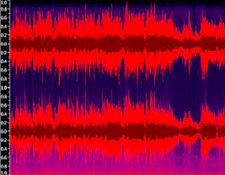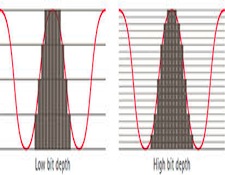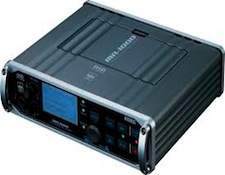It’s the time of year for saving money!
Recently I’ve seen several of what I choose to call “push back” articles by individuals who believe that human beings don’t need music with any higher sample/bit rate than 44.1/16. By and large their reasoning for this is based on the Nyquist frequency theory. They reason that since 44.1 samples at frequencies up to 20KHz and the average human can’t hear that high, that 44.1 is a more than high enough sample rate. Also these same folks claim that 16 bits is enough bit depth because it has enough signal to noise range to cover “everything from a pin-drop to a supersonic engine” but just because 16-bits can span that dynamic range doesn’t mean it can do it well.
 Since no one else has given these folks a proper name that’s printable I’m going to call them the “good enoughers.” Since 44.1/16 is “good enough” in theory, there is no need for any empirical judgments or actual listening to determine if there are sonic advantages to higher bit and sample rates. They are the equivalent of the owner of a racing car who decides there’s no need for a vehicle to have more than 300 horsepower because the brakes can only stop it “well” if it goes under than 150 MPH.
Since no one else has given these folks a proper name that’s printable I’m going to call them the “good enoughers.” Since 44.1/16 is “good enough” in theory, there is no need for any empirical judgments or actual listening to determine if there are sonic advantages to higher bit and sample rates. They are the equivalent of the owner of a racing car who decides there’s no need for a vehicle to have more than 300 horsepower because the brakes can only stop it “well” if it goes under than 150 MPH.
Of course, I think this is wrong.
 The most important aspect of higher definition music (above 44.1/16) is its increased inner detail and low-level definition compared to the same material at 44.1/16. As far as I know, there’s still no way to measure, quantify, and calculate an improvement in detail or definition, so “good enoughers” have no way to even begin to understand what a qualitative difference increased inner detail and low-level resolution have on the listening experience. And listening for themselves seems to be out of the question…
The most important aspect of higher definition music (above 44.1/16) is its increased inner detail and low-level definition compared to the same material at 44.1/16. As far as I know, there’s still no way to measure, quantify, and calculate an improvement in detail or definition, so “good enoughers” have no way to even begin to understand what a qualitative difference increased inner detail and low-level resolution have on the listening experience. And listening for themselves seems to be out of the question…
For someone who’s been trying for more than 40 years to get to the point with audio fidelity that the primary audible limitations are caused by the initial recording methodology, not by playback chain, this idea that 44.1/16 is “more than enough” is so counter-productive to the goals of higher fidelity as to be considered from a moral point of view, as evil. Of course the “good enoughers” believe they have the moral high ground against all the “snake oil salesmen” in the audio world. We NEED their protection like a vegetarian needs growth hormone-free beef…
 “Good enoughers” believe that they are scientifically and morally superior to us old-style audiophiles. They also believe that anyone who champions higher definition digital audio must be a charlatan or dupe. But the reality is that these people are so distrustful of their own senses that they are afraid to actually listen to and experience what a well-recorded high-resolution digital recording sounds like through a high-resolution audio system and compare it to the same recording that has been down-sampled to 44.1/16. I have been making these comparisons for over five years now, ever since I began making my own recordings at DSD 128x. The differences are not subtle, but they are not about frequency response, or signal to noise ratio. Instead the audible differences between red-book 44.1/16 and higher sample/bit-rate PCM and DSD recordings are about depth recreation, dimensionality, inner detail, and lack of electronic grain; which are all difficult, if not impossible, to quantify.
“Good enoughers” believe that they are scientifically and morally superior to us old-style audiophiles. They also believe that anyone who champions higher definition digital audio must be a charlatan or dupe. But the reality is that these people are so distrustful of their own senses that they are afraid to actually listen to and experience what a well-recorded high-resolution digital recording sounds like through a high-resolution audio system and compare it to the same recording that has been down-sampled to 44.1/16. I have been making these comparisons for over five years now, ever since I began making my own recordings at DSD 128x. The differences are not subtle, but they are not about frequency response, or signal to noise ratio. Instead the audible differences between red-book 44.1/16 and higher sample/bit-rate PCM and DSD recordings are about depth recreation, dimensionality, inner detail, and lack of electronic grain; which are all difficult, if not impossible, to quantify.
It seems as if “good enoughers” are convinced that they need to free us of our audio “superstitions.” I think that our “superstitions” are the only thing that keeps the industry moving forward toward the goal of a transparent signal chain that leaves music unmolested by format deficiencies.
 Finally, it’s important to remember that what might be “good enough” for one person may very well be “not acceptable” for a critical listener. If you don’t want or don’t feel that you need to listen to higher definition music to enjoy it, good for you…but I want more fidelity and I’ve proved to myself on many occasions that high definition digital recordings have greater fidelity than 44.1/16 down-sampled versions from the same high-definition master.
Finally, it’s important to remember that what might be “good enough” for one person may very well be “not acceptable” for a critical listener. If you don’t want or don’t feel that you need to listen to higher definition music to enjoy it, good for you…but I want more fidelity and I’ve proved to myself on many occasions that high definition digital recordings have greater fidelity than 44.1/16 down-sampled versions from the same high-definition master.
That’s my reality, and it’s not going to change because a non-listener tells me that what I’m hearing doesn’t exist…





